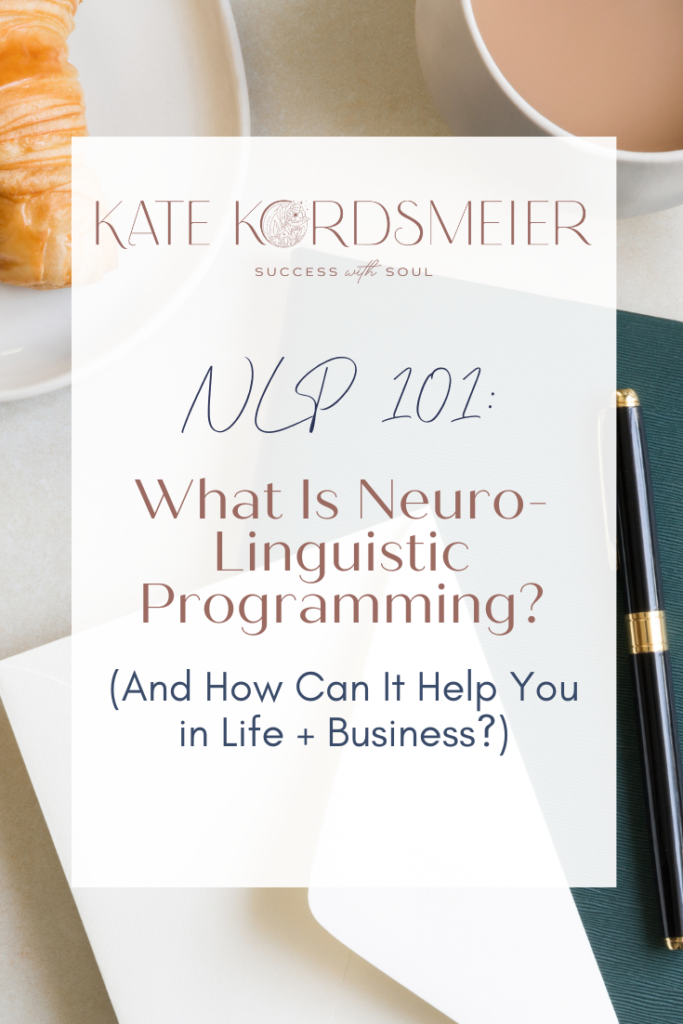Learn my secrets to creating a successful online business with my holistic strategies and soulful marketing advice for heart-centered entrepreneurs who value relationships, mindfulness, spirituality and health as much as strategic action and practical tips.
LEARN MORE →
Success with Soul Incubator
Success with Soul Shop
Launch Your Dream Offer Mini Course
Our most popular posts to help you create, grow and monetize your online business with soul!
EXPLORE POSTS →
Income Reports
Passive Income
Increasing Traffic
NLP 101: What Is Neuro-Linguistic Programming and How Can It Help You in Life + Business?
December 7, 2022
Kate Kordsmeier
Hi, I’m Kate
Working mom, writer, educator and creative entrepreneur.
LEARN MORE →
Learn how to make money WITHOUT social media
free to join →
Explore a few of our favorite topics
INCREASING TRAFFIC
PASSIVE INCOME
INCOME REPORTS
Want weekly accountability + coaching?
Join our mastermind, The Room, the most powerful hour of your week. Clients who show up for these calls get better results faster—period. With weekly live coaching calls and monthly Get it Done Weeks, you'll actually (finally!) make progress in your business.
START FOR JUST $7 →
A holistic system for aspiring coaches, course creators + heart-centered entrepreneurs. Learn how to launch your business, launch your website and launch your offer(s), even if you have no idea where to start. Only $9!
READY FOR YOUR DREAM?
The Mindful Business Academy
Your All-Access Pass to a social-free, six-figure+ biz
LEARN MORE →
Last Updated on December 7, 2022
Neuro-Linguistic Programming (NLP) is a map of how our brains work, and using the techniques of NLP can reprogram your brain for success. So if you’ve been struggling with limiting beliefs, self-sabotaging patterns, or habits that you just can’t seem to break no matter how much you try — NLP might be just the tool for you!

Table of Contents
What Neuro-Linguistic Programming Can Do For You
You’re probably already familiar with, and likely already use, some of the key concepts employed in Neuro-Linguistic Programming techniques (maybe without consciously realizing these were NLP techniques) — visualization, affirmations, body-language mirroring, anchoring … but there is so much more to it than that.
Neuro-Linguistic Programming is a collection of techniques, processes, and attitude adjustments for creating change in people.
In his book Applications of Neuro Linguistic Programming (1983), NLP developer and practitioner Robert Dilts defines NLP as a map of how our brains work, how language interacts with the brain, and how to use this information to systematically and methodically “reprogram” ourselves.
In short, NLP reprograms your brain for success, in any and all areas of your life.
The techniques of NLP help individuals by showing them how to better communicate with themselves (if that sounds a little odd, don’t worry, I’ll explain more later on) and it can also help you learn how to communicate with others better — which leads to better relationships, more success in business, and generally an easier and more pleasant life all around.
What is NLP + Where Does the Term Come From?
To get a little bit better idea of how a simple NLP technique could possibly be helpful in so many ways let’s dive a little deeper into what it actually is:
Neuro: Relating to the mind or brain, in particular how our state of mind (and body) affects communication and behavior. NLP teaches a structural way of viewing mind and body states, developing mental maps that help us discover how things happen and how we can change course towards our desires.
Linguistic: Language is the tool that we use to gain access to the inner workings of our minds (and others’ minds). Neuro-linguistic programming teaches us how to access unconscious information that would otherwise remain hidden and unknowable.
Programming: We are all living according to our programming, which consists of habitual thoughts, feelings, reactions, beliefs, and traditions. The great news is that you have the ability to reprogram your mind at any time to create the life you want.
Part of the process of neuro-linguistic programming is accessing the auto-pilot of your mind and reprogramming it for success.
Is NLP the same as Hypnotherapy?
I want to touch on hypnotherapy briefly here because it’s often confused with Neuro-Linguistic Programming. Some NLP practitioners are trained in and use hypnotherapy along with the many other techniques, but hypnotherapy is not the same as NLP, nor is it necessary for success with NLP. It can, however, be another powerful tool in your NLP toolbox!
P.S. Kate Kordsmeier (hi, that’s me!) is currently getting certified in both NLP and Hypnotherapy, which she uses in coaching her clients inside the Incubator.
A quick note on the two (very different!) types of NLP
One side note before we move on: be careful not to confuse Neuro Linguistic Programming with other NLPs out there. If you google “NLP,” you might get lots of results for Natural Language Processing, which sounds quite similar, but is a different thing altogether.
Natural Language Processing refers to a branch of computer science (more specifically in the field of artificial intelligence) concerned with giving computers the ability to understand text and spoken words in the same way human beings can. That is not what we’re talking about here today.
Neuro-Linguistic Programming Techniques
NLP might be a new term for you, but it’s been in wide practice for quite some time.
NLP was developed in the 1970s at the University of California, Santa Cruz, primarily by John Grinder, a linguist, and Richard Bandler, an information scientist and mathematician.
In the late 1970s, Bandler and Grinder began marketing NLP as a tool for people to learn how to achieve success, and interest in the practice began to grow.
Since then, NLP has been used across a wide variety of fields, including counseling, medicine, law, business, performing arts, sports, the military, and education.
NLP has also been used to treat a wide range of mental and physical issues, including anxiety, phobias, PTSD, depression, ADHD, addiction, schizophrenia, obsessions and compulsions, borderline personality and many more.
Not all neuro-linguistic programming techniques are used to create change, or for physical or psychological healing. Many are used to improve communication and management skills.
In business, for example, the techniques of NLP provide business leaders with the ability to establish great rapport with coworkers and clients, understand and overcome objections, and conduct better presentations and meetings.

NLP Techniques You Can Implement Today
According to nlp-techniques.org there are 100+ techniques that can be employed in the practice of NLP. (If you want to dig deeper into NLP, that website is a great place to start.)
You certainly don’t need to use all 100+ techniques to see results — any one, or combination of a few, can get you results. The sheer volume of options is one reason why you might want to work with a trained and certified practitioner, like me!
Today we’re going to focus on just a few of the more common techniques to give you a little bit more of an idea of what NLP is.
One thing to note about all NLP techniques is that they are action oriented. NLP is more concerned with how to change a behavior, rather than why the behavior exists in the first place.
This is kind of like the difference between therapy, which tends to focus on the past, and coaching, which tends to focus on the future. NLP is a technique I use in my coaching practice.
1. Mental Rehearsal
Mental rehearsal is a classic NLP technique based on visualization. It’s a great first exercise for beginners because it’s straightforward and linear. You want to create a highly detailed visualization of yourself successfully performing some action — nailing a sales pitch, perfecting and launching your successful evergreen webinar, whatever is coming up for you. Picture the scene, imagine yourself feeling totally comfortable, determined and 100% confident of your success. FEEL those feelings, see the scene play out in your imagination in as much detail as possible, and don’t forget to follow it through until the successful end. Let yourself enjoy the accomplishment as if it’s already happened, because it will.
2. NLP Swish
The NLP Swish is a way of telling your brain “this, NOT that.” You tell your brain what you DON’T want, and then replace that with what you DO want. Like your own fairy godmother, you’re swishing away the bad and swishing in the good.
First, create a detailed, vivid picture in your mind of whatever it is you don’t want. Make it big and bright. Then create a vivid picture of what you want to replace it with, making that mental image small and dull, like it’s far away.
Now reverse the images. Move the image of what you want into the foreground, making it brighter and brighter — adding in triumphant music and motion. Swish the image of what you don’t want into the background while making it gray and colorless.
Repeat the exercise three to five times.
NLP swish tells your brain exactly what you want (and don’t want) as well as training your brain to amplify positives, and weaken the negatives.
This is a technique that is best done with a certified NLP practitioner who can guide you through the exercise so you can focus on the visual without getting bogged down in what to do next.
3. Modeling
Simply put, modeling is the NLP technique of studying successful people and emulating them.
You can model anyone who has achieved success in an area you are interested in. It doesn’t have to be someone you know, it doesn’t even have to be someone still alive. You can read biographies, watch documentaries, anything that gives you insight into how they achieved the success you’re looking for.
In order to make the most of modeling, you should also surround yourself with people in real life who are achieving the things you want to achieve, and pay attention to how they do what they do and model them.
After all, 95% of success is who you spend your time with.

4. Mirroring
We’ve touched a little bit already on how NLP can be used to influence other people’s behavior as well as your own, one of the techniques you can use to influence others is mirroring.
Only a portion of anything we say is communicated through words. Tone of voice and body language communicate just as much, and often more than our actual words.
Mirroring is an NLP technique that takes advantage of this non-verbal communication to build rapport and make instant connections with anyone. When you’re talking to someone, mirror their body language. If they’re high energy, raise your energy level to match. If their body language is relaxed, become relaxed. You can even choose words to match their vocabulary. The other person will automatically find you more trustworthy because they see you as being more like them.
5. Incantations
Some people describe Incantations as a more powerful version of affirmations, which you are probably familiar with. An affirmation is a phrase you repeat to yourself about your beliefs and/or goals. Incantations take it a step further, changing your physiology as well as your words to create a state of total confidence. Incantations should be crafted, and repeated in a way that engages you emotionally and physically — use emotionally charged language and repeat your incantations with energy and confidence.
Should You Work With An NLP Practitioner?
Whether or not you work with an NLP practitioner depends on what you want to achieve and how much research and work you want to put into it.
There are lots of resources out there — books, videos, podcasts, training courses that can teach you various aspects of NLP that you can use on yourself, and probably get great results! But, as with most things, working with a trained, experienced professional is going to get you quicker, and perhaps ultimately better results.
If you’re not quite ready to take the plunge and hire an NLP professional (or your budget isn’t quite ready for you to take that plunge), I recommend starting with a book or some podcasts and implementing a few strategies that you resonate with. Once you get a little further along on your own exploration, you might at some point choose to work with a professional.
I am currently training to become a certified NLP practitioner, and graduated from the Quantum Coaching Academy in November 2022. I’m excited to incorporate these powerful techniques of NLP into our Success With Soul program, and other coaching offers!
Ready to Go From “Stuck” to “Sprint”?

Frequently Asked Questions About Neuro-Linguistic Programming
What is Neuro-Linguistic Programming?
Neuro-Linguistic Programming is a collection of techniques, processes, and attitude adjustments for creating change in people. In his book Applications of Neuro Linguistic Programming (1983), NLP developer and practitioner Robert Dilts defines NLP as a map of how our brains work, how language interacts with the brain, and how to use this information to systematically and methodically “reprogram” ourselves. In short, NLP reprograms your brain for success, in any and all areas of your life.
What Are Some Useful Neuro-linguistic Programming Techniques that can help in business?
Mental Rehearsal, NLP Swish, Modeling, Mirroring, and Incantations are 5 of the most common NLP techniques that we cover in this post. They are powerful tools for personal development, and also for entrepreneurs who are looking to break old limiting patterns and start new empowering ones in their businesses.
Should I work with a certified NLP Practitioner?
As with all healing modalities, it can be very useful to work directly with someone who is familiar with the techniques of NLP and can help you approach them in the best way. It’s possible to learn some basics of neuro-linguistic programming techniques on your own, but if you want to become truly proficient and maximize the benefits of NLP, I highly recommend working with a certified NLP practitioner.
I am currently training to become a certified NLP practitioner, and graduated from the Quantum Coaching Academy in November 2022. I’m excited to incorporate these powerful techniques of NLP into our Success With Soul program, and other coaching offers!
This post may contain affiliate links. Read about our privacy policy.

Just Between Us 
There are juicy deals and insider-only offers that I share only with my email community. If you love a good behind-the-scenes peek, let’s make it official and get you on the Whole Soul List, a sacred pause for heart-centered, ambitious entrepreneurs. See what it's truly like to unsubscribe from the status quo and create a life and business on your terms.
IT'S MORE THAN A LIST; IT'S A MOVEMENT!
Where are you in your business?
I don't have a biz yet + don't know where to start, but know I'm meant for more!
SOUNDS LIKE ME! →
I'm busy and overwhelmed, desperate for work-life balance
Yes! Tell me more →
I have an online business and want to sustainably scale without social media.
I’m so ready for this →

FEELING OVERWHELMED?
There’s only one way to eat an elephant (hint: one bite at a time!) and our 30-step roadmap to starting an online business will help you check things off your to do list like a pro!
YES, PLEASE!
JOIN US ON SLACK
Join our client/student-only, social-media-free VIP Soul Circle on Slack to connect with other heart-centered entrepreneurs on the path to success with soul!
JOIN OUR COMMUNITY →
EVERYTHING
about
THE SHOP
AFFILIATE PROGRAM
resources
the blog
THE podcast
Your New Sunday Ritual: the Whole Soul List newsletter
COPYRIGHT © 2024 • SUCCESS WITH SOUL LLC
Subscribe →
We are an LGBTQIA-affirming, interfaith-oriented, diverse organization. We are committed to social and environmental justice, including civil rights, dismantling systems of oppression like the Patriarchy, White Supremacy and Diet Culture. We believe Black Lives Matter.
login
